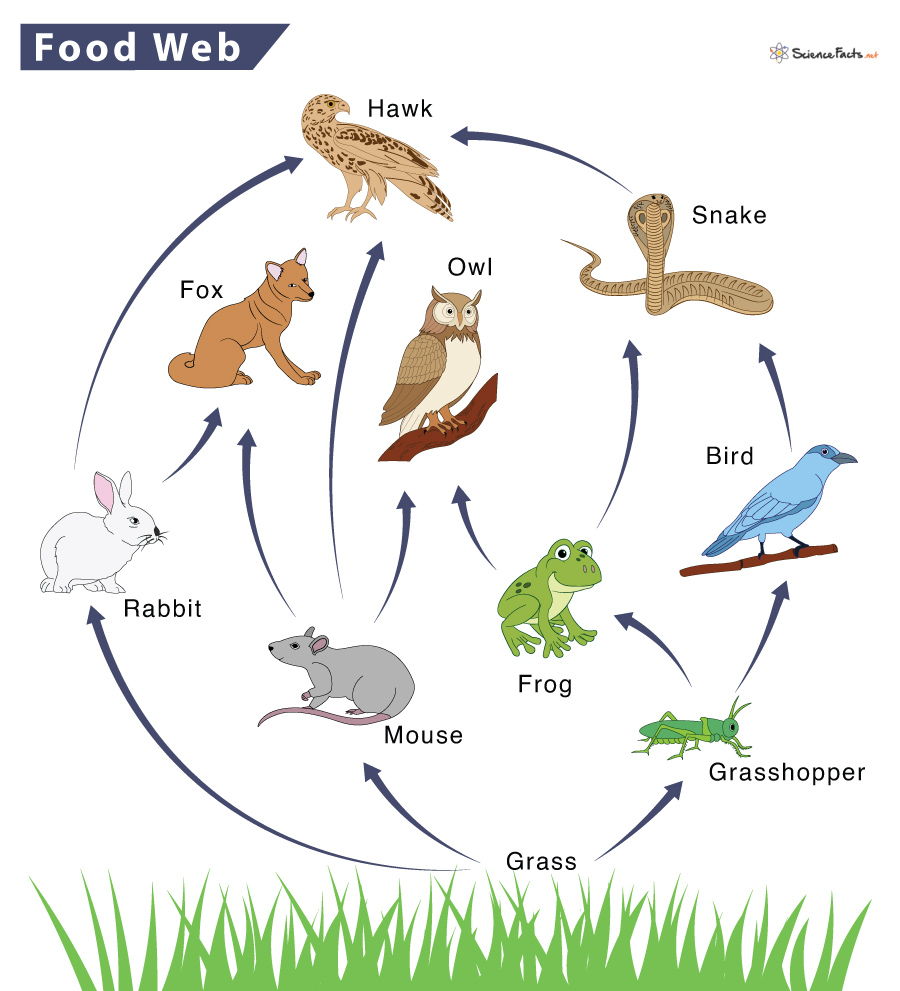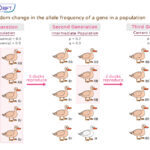Food Web
A food chain shows a single feeding pattern between a predator and a prey in an ecosystem. However, in reality, the relationship between them is much more complex. An organism can have multiple food sources (prey) and simultaneously be eaten by multiple predators. Such a relationship is represented pictorially using a food web.
It consists of all the interconnected and overlapping food chains in an ecosystem. Each living organism is part of multiple food chains that shows a possible path that energy and nutrients follow as they move through the ecosystem.
Previously known as the food cycle, the food web model was developed by Charles Elton in his book Animal Ecology in 1927.
Food Web Trophic Levels
Organisms in food webs are grouped into four groups or trophic levels. They are:
Producers
Producers or autotrophs make up the first trophic level of the food chain. They prepare their own food from sunlight, carbon dioxide, and water through photosynthesis. All other organisms in the ecosystem use them for food.
Although green plants are the most abundant autotrophs on Earth, algae, phytoplanktons, and autotrophic bacteria living in volcanoes and hydrothermal vents can also produce food for themselves.
Primary Consumers
The second trophic level consists of herbivores that depend on producers for food. Cow, deer, elephant, and mice are primary consumers in the grassland ecosystem that consumes grasses, shrubs, and trees. In contrast, many fish and turtles are herbivores in the ocean ecosystem that eat algae and seagrass. In forests, sea urchins act as primary consumers, eating dozens of kelp daily.
Secondary Consumers
Secondary consumers are the organisms that reside on the third trophic level and depend on primary consumers for food. They can be carnivores or omnivores. Carnivores eat other animals, whereas omnivores eat both plants and animals.
In a desert, a snake is a secondary consumer, eating mice. At the same time, in forests, sea otters are secondary consumers that hunt sea urchins. Humans, bears, and foxes are examples of omnivores in the terrestrial ecosystem.
Tertiary Consumers
Tertiary consumers eat secondary consumers and are found at the last or the fourth trophic level. In deserts, an owl or an eagle is a tertiary consumer eating a snake.
There are more levels of consumers above the tertiary consumers. Apex consumers residing at the top of the food chain are organisms that feed on other consumers for food. Such organisms have no natural enemies except humans. In the grassland ecosystem, lions or tigers, in the sea, sharks, and deserts, bobcats are examples of apex predators.
Detritivores and Decomposers
They are associated with the last part of detrital food webs. Detritivores such as vultures eat dead plant and animal remains. At the same time, decomposers like fungi and bacteria turn dead organic matter into inorganic materials in the soil.
These organisms complete the cycle by returning the nutrients to the soil that producers absorb to start a new food chain.
How does a Food Web Work
In a terrestrial (grassland) ecosystem, the grass is the primary producer. A grasshopper eating the grass is the primary producer that a frog, a secondary consumer, eats. A snake, the tertiary consumer of the ecosystem, then eats the frog. Finally, the snake is consumed by a hawk, the apex consumer of the grassland ecosystem. After the hawk’s death, decomposers release nutrients into the soil to be utilized by the producers.
The above is an example of the food chain, which is only a part of the food web. In another part of the food chain, a caterpillar (primary consumer) eats the leaves of plants (producers) which are eaten by birds like sparrows (secondary consumer). A snake (tertiary consumer) preys on the sparrow, which an eagle, the apex consumer, eats. Finally, a vulture feeds on the eagle to complete the chain. Decomposers decompose the eagle upon its death.
The above food chains coincide in the ecosystem with many others, where one organism has more than one prey. Similarly, the same organism can have many predators forming an interconnected network of predator-prey relationships across different trophic levels of the ecosystem – the food web.
Types of Food Web
There are different types of food webs based on how it is prepared or what they emphasize. Scientists often classify food webs based on the type of ecosystem being presented into the following types:
1. Connectance Food Webs
Scientists use connectance food webs to depict the predator-prey relationship. Here, all the arrows on the web are equally weighted.
2. Interaction Food Webs
Similar to the connectance, in interaction food webs, scientists use arrows to display the predator-prey relationship. In addition, here, the arrows used are made wider, bolder, or darker to denote the strength or degree of consumption of one species by another.
3. Energy Flow Food Webs
Energy flow food webs depict the relationship between organisms by measuring and showing the energy flux between organisms.
4. Fossil Food Webs
In fossil food webs, the relationship between organisms is established based on fossil records.
5. Functional Food Webs
Functional Food Webs show how population changes influence the growth rate of other populations within the ecosystem.
-
References
Article was last reviewed on Friday, February 17, 2023






